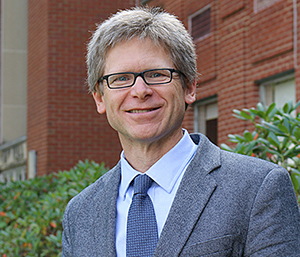 Erik Anderson, professor of Mechanical Engineering
Erik Anderson, professor of Mechanical Engineering
A high-tech water tank designed by Grove City College Senior Mechanical Engineering majors and Professor Erik Anderson has resulted in research published in the Journal of Experimental Biology.
The device generates turbulence in precise amounts to mimic ocean turbulence. Anderson was part of the team that conducted the research at Woods Hole (Mass.) Oceanographic Institution, where he is a guest investigator. The work probed the effect of turbulence on swimming behavior in plankton — organisms that are vital to the ocean food chain and fisheries.
“Oceans exhibit a range of turbulence, from the quieter, deeper off-shore region to the chaotic, shallow surf-zone,” Anderson said. “Understanding how this gradient of turbulence impacts the dispersal of plankton may be vital to predicting the health of the ocean food chain. The well-being and distribution of plankton — from fish larvae to photosynthetic microorganisms— is of major economic and ecological significance.”
Anderson and his collaborators, along with other scientists, have been exploring the behavior of plankton in turbulence for more than 20 years, but the field is plagued by the difficulty of producing repeatable levels of what is known as homogeneous, isotropic turbulence.
In 2004, a group at Georgia Tech led by Don Webster, a scientific colleague of Anderson, designed and built a unique “turbulence tank.” It used subwoofer speakers to squirt water into a cubical tank at each of its eight corners, but difficulties controlling the squirting, and thus the turbulence, made the tank impractical for large-scale experimental studies. During the 2012-13 academic year, Grove City College Mechanical Engineering majors advised by Anderson and in communication with Webster, built a replica of the G-Tech tank with several upgrades. The new tank was a dramatic improvement and featured on WHOI’s website, but still proved too difficult to control.
Refusing to give up, Anderson and three more years of senior design teams (2016 – 2019) worked on a solution inspired by the professor’s late grandfather — an engineer and business owner who designed and manufactured metal bellows for the aerospace industry. “I remember, when I was a kid, my grandfather showing me these bellows he made that looked like tiny accordions,” Anderson said.
He and his teams used bellows, subwoofers, and motion sensors to create essentially tiny precision squirt guns, capable of shooting sub-milliliter volumes of water into the turbulence tank at frequencies of 20 to 100 squirts per second and higher. These pulsed “jets” of water can be set to specific squirt volumes and frequencies to generate highly repeatable levels of turbulence.
The Journal of Experimental Biology paper – “Responding to the signal and the noise: behavior of planktonic gastropod larvae in turbulence” – was published this spring. It was coauthored by Anderson, Michelle DiBenedetto of WHOI and the University of Washington, Lauren Mullineaux and Karl Helfrich of WHOI, and Anthony Pires of Dickinson College.
In the text and acknowledgements of the paper, the authors credit the Grove City College Mechanical Engineering students for their contribution. One of the reviewers of the paper wrote, “They rebuilt Webster et al.’s…turbulence tank!!…AND made it better. Bravo!”
“The device is a testament to the excellence of the Mechanical Engineering program and a notable example of how research enhances the outcomes and prestige of the STEM program at GCC,” Anderson said.
The opportunity for undergraduates to be involved in this research at GCC and WHOI was made possible by the Swezey and Jewell, Moore and MacKenzie funds and the Mechanical Engineering Senior Capstone Design program led by Dr. Vern Ulrich. Opportunities like this have propelled students from Anderson’s lab to internships, graduate work, and faculty positions at schools such as MIT, Princeton, Vanderbilt, Baylor University, and the U.S. Naval Academy.
Grove City College alumni who contributed to the design and construction of the GCC Turbulence Tank as students are: from the class of 2012 – Seth Brooks, Michael Giammaria, Kyle Hay, Brenna (McGann) Schaeffer, Paul Schaeffer, Allen Schertz, and Philip Tan; the class of 2016 – Ben Nasman and Ransom Erb; the class of 2017 – Danielle Comly, Molly Gallant, Madi Mitchell, Dan Moll, Mitch Newburg, Tim Wolfe, and Micayla Wright; the class of 2018 – Abby (Noll) Allen, Graham Allen, Sam Farley, Hannah Hood, Katelin Omecinski, Sarah Payne, Ryan Zellers, and the class of 2019 – Garrett Finnegan, Megan Hunt, Evan Lundburg, Mark Mutigli, Shannon Stovar, and Trent Strick.
For more about the Department of Mechanical Engineering at Grove City College, visit gcc.edu/mece.